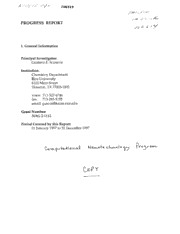
NASA Technical Reports Server (NTRS) 19980211155: Computational Nanotechnology Program PDF
Preview NASA Technical Reports Server (NTRS) 19980211155: Computational Nanotechnology Program
206519 /" /_, / { /, _/ ,_ . PROGRESS REPORT /6 -_', & f _,/ 1. General Information Principal Investigator: Gustavo E. Scuseria Institution: Chemistry Department Rice University 6100 Main Street Houston, TX 77005-1892 voice: 713-527-4746 fax: 713-285-5155 email: [email protected] Grant Number: NAG 2-1112 Period Covered by this Report: 01 January 1997 to 31 December 1997 _ _,,.._-k--o..k,,,,-_Io=)_K C,oP¥ 2. Objectives: (a) The development of methodological and computational tools for the quantum chemistry study of carbon nanostructures. (b) The development of the fundamental understanding of the bonding, reactivity, and electronic structure of carbon nanostructures. 3. Status of Effort: (a) Methodological Developments: Continuing with our efforts to develop fast methods for very large molecular systems, we are in the process of implementing a new linear scaling method for tight-binding calculations of very large carbon molecules. The new method is based on a Chebyshev polynomial expansion of the Hamiltonian and complements our previous effort on the conjugate gradient density matrix search (CGDMS) method that replaces the Hamiltonian diagonalization. We are currently benchmarking the new technique against diagonalization and CGDMS. The new method promises to be much faster than CGDMS, thus opening the possibility of MD simulations of carbon nanostructures in much shorter computational times. (b) Applications: Several studies have been carried out during the first year of this grant. Two papers have been accepted for publication, and three more are currently in preparation (see below). Electronic structure calculations were carried out on C240, large buckyonions, the (10,10) single-wall nanotube (SWNT), and many other fullerenes, during the first year of this research grant. (c) Carbon Nanotubes: Fullerenes and carbon nanotubes are materials with many interesting properties. Our research group has been active in theoretical predictions of these systems for many years. A recent breakthrough in the large yield macroscopic production of single wall nanotubes of uniform diameter will facilitate experimental applications of these tubes as proximal probes and in composite materials. Our group continues to work closely with leading experimental groups in this field. We are interested in studying the reasons why the (10,10) buckytube is preferred in the macroscopic preparation, and developing the chemistry of the carbon nanotubes. 4. Accomplishments: Our calculations have continued to play a central role in understanding the outcome of the carbon nanotube macroscopic production experiment. The calculations on buckyonions offer the resolution of a long controversy between experiment and theory. Our new tight binding method offers increased speed for realistic simulations of large carbon nanostructures. 5. Personnel supported: PI : 1 month of summer salary One postdoctoral research associate Two graduate students and 1 undergraduate (partial support) 6. Publications Acknowledging NASA Support During this Report Period: 1. C240 .... The most chemically inert fullerene? R. C. Haddon, G. E. Scuseria, and R. E. Smalley, Chem. Phys. Lett. 272, 38-42 (1997). 2. Why are buckyonions round? K. R. Bates and G. E. Scuseria, Theoret. Chem. Accounts (in press). 3. Why is the (10,10) single-wall carbon nanotube special? G. E. Scuseria, D. T. Colbert, and R. E. Smalley, in preparation. 4. The C2 fragmentation energy of C60 revisited: disagreement between theory and experiment, A. D. Boese and G. E. Scuseria, in preparation. 5. A linear scaling Chebyshev polynomial expansion of the density matrix applied to carbon tight-binding electronic structure calculations, K. R. Bates and G. E. Scuseria, in preparation. 7. Work Funded by this Grant and Placed under the WWW The material described in this Progress Report has been placed in the www under the URL: http:llpchem1.rice.edu/~guscuslNAG2-1112.html Additional information about the Scuseria research group may be found under http://pcheml.rice.edu/~guscus/main.html 8. Plans for Next Year We will continue our program of developing methods and applying them to problems of relevance in Molecular Nanotechnology. Our focus will be limited to carbon exclusively although we also envision extending our tight binding methodology to hydrogen at a later stage. In our application studies, we will complement our tight- binding calculations with density functional calculations when the size of the systems will allow it. During the secondyearof this researchgrant we will start addressing the parallelization issues involved in our Chebyshev methodology. One of the main reasons driving our program development towards the Chebyshev expansion is it relative easefor massiveparallelization whereas the CGDMS method presents more serious challenges because of its extensive use of sophisticated sparse matrix multiplication tools. On the applications side, we will start modeling the chemistry of carbon nanotubes at their tips and walls. In particular, we are interested in understanding the chemical bonding, bond strength, and migration reactionsof radicals and metallocenesattached tothe carbon nanotubewalls, andthe dependenceof theseproperties with the diameter of the tube. This theoretical effort will becarried out in closecontactwith the Smalley group atRicewho is currently in theprocessof isolating and sorting individual SWNT pieces.Thestudy of the chemistry of thesenanostructures,who promise great potential for applications in composites,will becarriedout during the2ndyear of this grant.
